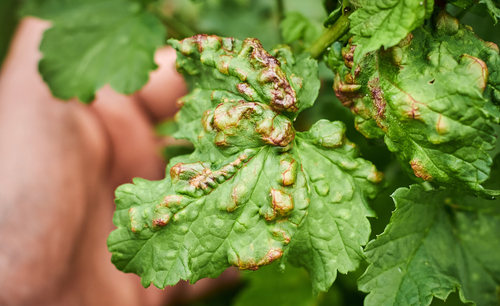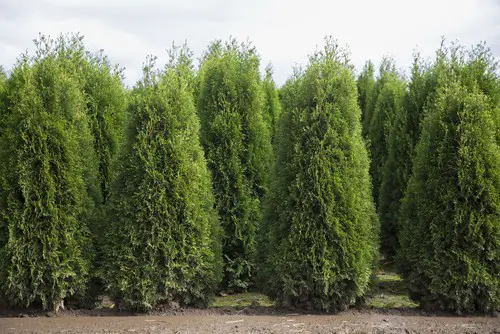It’s very common to find a Leyland cypress turning brown from the seasons changing or the needles shedding so new ones can grow. However, if you find that the browning is spreading or lasting over a season, something might be causing the issue.
Common causes of Leyland cypress turning brown and losing needles include root rot, fungal infections, pest infestations, and drought stress, all of which require timely intervention to prevent further damage to the tree.
Leyland Cypress Turning Brown

While it’s natural for your Leylands to turn brown with the turning of seasons or for a few needles to brown and fall off from time to time, seeing your cypress trees turning often and without obvious cause can be alarming.
If you see your Leyland cypress trees turning brown, it’s most likely because of sudden temperature changes or a disease you need to treat quickly, so it doesn’t infect the rest of the tree. The most common diseases are canker disease and blight.
1. Temperature Changes Harming Cypress Trees
While Leyland cypress trees are hardy against cold weather, any sudden shifts in temperature can cause damage. If the weather rapidly fluctuates, they aren’t very good at adjusting.
The sudden shift damages the water-conducting layers within the trees, resulting in browning. If you notice the needles dying from the tips inwards, this is a sign of dieback.
Long periods of windy weather can also cause browning since it dries out the tree.
2. Canker Disease on Leylands

Canker disease is a fungal disease that can cause Leylands to change color. The branches can experience dieback that eventually moves to the cypress’s truck, making it almost impossible to treat and save the tree.
It’s important to watch for signs of canker disease to prevent the entire tree from dying. The most common symptom is sunken dark brown patches on the branches, but you may also find small fungal growths. The branches will shift to yellow or brown colors.
The best way to eliminate a canker disease is to cut off the infected branches before it can spread further. If the cypress is still small, you can use fungicide and proper irrigation to prevent the disease. You can install an underground watering system or use a hose on the ground with a slow trickle of water over the root zone.
However, be careful when setting up an irrigation system since overwatering can cause issues like root rot and insect infestations. You’ll need to monitor your cypress sapling to see signs of overwatering before any damage occurs.
3. Blight Disease on Cypresses
Blight will cause accelerated browning of the leaves and branches, leading to them dying. Generally, the needles turn brown or gray before falling early. Leylands can turn brown and scarlet when they have a variant of blight disease called Kabatina tip blight.
Blight causes damage to the branches and slows down the Leyland’s growth, leading to the tree dying if the damage is extensive enough. The damage usually starts near the truck and the lower branches before moving up. Blight can also kill a cypress if it stunts its growth before the seasons change.
If there’s heavy rainfall and your Leyland is turning brown, you should look for other signs of blight. The best way to prevent this is to remove the infected area. You might want to transplant the cypress somewhere with more sun and air to prevent blight and only watering minimally.
4. Bagworm Infestation

Bagworms can cause havoc on a Leyland cypress. They use the needle fragments to form bags that contain insect larvae. The result is a lot of adult moths that can further damage the tree by feeding on the needles, reducing the chlorophyll matter and causing them to turn brown.
Luckily it’s pretty easy to check if bagworms are causing your cypress to turn brown since you’ll be able to see the webbing from the bags. Some pesticides can work, but they aren’t recommended for mature Leylands.
5. Moisture Stress in Leylands
If your Leyland’s roots cannot spread in the surrounding soil, this can cause moisture stress. You will need to water the tree more often to prevent it from running out of water. Also, check the soil to ensure it can help hold moisture.
Other weather and a lack of the cypress’s resources can also cause stress, such as heat and drought. All you can do is check on your Leylands to ensure they have what they need and consider replanting them somewhere that can give them the conditions they need.
6. Transplanting a Leyland

While transplanting your cypress can help ensure it has the protection from elements and soil quality it needs, it can also cause it to experience an initial period of stress where browning will increase.
Ensure that you’re transplanting early in the growing season so the Leyland will have plenty of time to adjust to its
How to Treat Leylands Turning Brown
There is no way to reverse the damage already done to Leyland. Your best option is to know the signs of the disease and remove the infected branch before the disease can spread to the rest of the tree. Then allow the cypress to grow a bit before pruning.
Ensure that you’re disinfecting the pruners before using them. You can disinfect your pruners using a mixture of six parts water and one part bleach. Don’t prune during damp weather because this can lead to disease.
If the weather conditions are causing the tree to brown, you may need to relocate it to somewhere with partial shade or wind coverage to ensure it doesn’t dry out when the weather changes.
You may also want to check the soil where the cypress is now, as it might not be the right fit. Leylands grow best in soil that is acidic, alkaline, loamy, moist, rich, well-drained, sandy, or clay. If the soil doesn’t match these, then you should transplant the cypress somewhere with better conditions.
Other posts on plant care:
Summary
The most common reasons for a Leyland cypress turning brown are changes in the weather, such as wind or temperature fluctuations, or the tree has a disease, such as canker or blight. You’ll need to transplant the tree somewhere with better conditions or prune the infected branches, so it doesn’t spread.
Frequently Asked Questions
How do you save a dying Leyland cypress?
The only effective treatment for Leyland cypress disease is to prune the infected branches and sterilize the pruners. Then you need to irrigate the plant regularly. Fungicides are not effective for Leyland cypress diseases.
How do you know if a cypress tree is dying?
You will know if a cypress tree is dying when the needles turn brown and fall off during a prime time of the season when the needles should be lush and green. If your cypress tree has brown needles all year round, it is dead, and you should remove it.
Do cypress trees turn brown?
It is not uncommon for some of a cypress tree’s needles to turn brown from time to time, whether shedding the old needles or the season changes. However, it shouldn’t happen often. If it does, you should immediately take action to preserve the rest of the tree from infection or disease.
What causes brown spots on cypress trees?
Cypress trees occasionally get brown spots which are usually because of cypress aphids. Damage from cypress aphids causes damage you won’t see until late spring and summer.

Hey, I’m Lisa and I’ve been an avid gardener for over 30 years. I love writing, talking and living in the garden! Feel free to connect with me on my socials below

